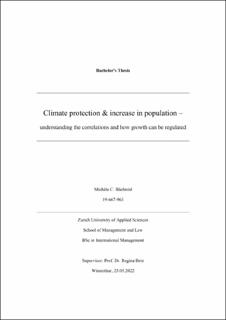Please use this identifier to cite or link to this item:
https://doi.org/10.21256/zhaw-26813| Publication type: | Bachelor thesis |
| Title: | Climate protection and increase in population : understanding the correlations and how growth can be regulated |
| Authors: | Bächtold, Michèle |
| Advisors / Reviewers: | Betz, Regina |
| DOI: | 10.21256/zhaw-26813 |
| Extent: | 90 |
| Issue Date: | 2022 |
| Publisher / Ed. Institution: | ZHAW Zürcher Hochschule für Angewandte Wissenschaften |
| Publisher / Ed. Institution: | Winterthur |
| Language: | English |
| Subject (DDC): | 363: Environmental and security problems |
| Abstract: | Actions to counteract climate change are becoming increasingly urgent and are the subject of intense discussions, whether by companies, organizations, or politicians. One factor that needs to be addressed to decrease CO2 emissions is the growing world population. Overpopulation leads to the overuse of resources, resulting in supply shortages, increased waste generation, and severe environmental impacts. Therefore, population growth rates need to decrease. This thesis examines various measures that lead to a drop in population growth rates. It compares coercive measures such as the one-child policy in China and sterilizations in India with development measures that include different sociocultural factors such as education, cultures, and health systems in Haiti, Nigeria, and Pakistan. Data will be obtained from a literature review and expert interviews. The literature review creates a thought model that identifies factors positively or negatively contributing to population growth. Furthermore, the policies of China and India are examined. By analyzing these coercive measures against population growth, the comparison with the development measures will be made feasible. By interviewing experts, current insights into the actions being taken in Haiti, Nigeria, and Pakistan will be provided. It will be shown whether the coercive measures are more sustainable than the indirect measures, what factors contribute to population growth in different countries, and how and why population mitigation measures differ. The results confirm that the connection between population growth and increased CO2 emissions persists. The more people, the higher the CO2 emissions and the higher the resource depletion. It was also found that coercive policies in China and India decreased the population growth rate. However, they cannot be described as more efficient than other measures since the current situations show that growth in India is still strong and development has not continued. Moreover, in China, growth is being encouraged again. Thus, the measures are not sustainable in the long run, and the enforcement of the policies is against fundamental human rights. The indirect measures for population mitigation can be summarized as follows: access to education, especially for women, awareness, normalizing, and dissemination of contraceptives and family planning, improved economic situations and inclusion of women in the workforce, better health systems, and government support in these areas. Different factors were identified by the experts as the most decisive. However, countries II should promote all these measures to develop and for population growth rates to decrease. Yet, no one right approach fits every country due to different states of development and cultures, religions, and attitudes that complicate the implementation of these measures. Although the support of women's autonomy, sex education, and normalization of contraceptives stands out as an approach, that by itself could decrease population growth rates in all kinds of countries, due to the obstacles mentioned above, it is challenging to implement it in practice. |
| URI: | https://digitalcollection.zhaw.ch/handle/11475/26813 |
| License (according to publishing contract): | CC BY-NC-ND 4.0: Attribution - Non commercial - No derivatives 4.0 International |
| Departement: | School of Management and Law |
| Appears in collections: | BSc International Management |
Files in This Item:
| File | Description | Size | Format | |
|---|---|---|---|---|
| 2022_Baechtold_Michele_BSc_IM.pdf | 7.02 MB | Adobe PDF |  View/Open |
Show full item record
Bächtold, M. (2022). Climate protection and increase in population : understanding the correlations and how growth can be regulated [Bachelor’s thesis, ZHAW Zürcher Hochschule für Angewandte Wissenschaften]. https://doi.org/10.21256/zhaw-26813
Bächtold, M. (2022) Climate protection and increase in population : understanding the correlations and how growth can be regulated. Bachelor’s thesis. ZHAW Zürcher Hochschule für Angewandte Wissenschaften. Available at: https://doi.org/10.21256/zhaw-26813.
M. Bächtold, “Climate protection and increase in population : understanding the correlations and how growth can be regulated,” Bachelor’s thesis, ZHAW Zürcher Hochschule für Angewandte Wissenschaften, Winterthur, 2022. doi: 10.21256/zhaw-26813.
BÄCHTOLD, Michèle, 2022. Climate protection and increase in population : understanding the correlations and how growth can be regulated. Bachelor’s thesis. Winterthur: ZHAW Zürcher Hochschule für Angewandte Wissenschaften
Bächtold, Michèle. 2022. “Climate Protection and Increase in Population : Understanding the Correlations and How Growth Can Be Regulated.” Bachelor’s thesis, Winterthur: ZHAW Zürcher Hochschule für Angewandte Wissenschaften. https://doi.org/10.21256/zhaw-26813.
Bächtold, Michèle. Climate Protection and Increase in Population : Understanding the Correlations and How Growth Can Be Regulated. ZHAW Zürcher Hochschule für Angewandte Wissenschaften, 2022, https://doi.org/10.21256/zhaw-26813.
Items in DSpace are protected by copyright, with all rights reserved, unless otherwise indicated.